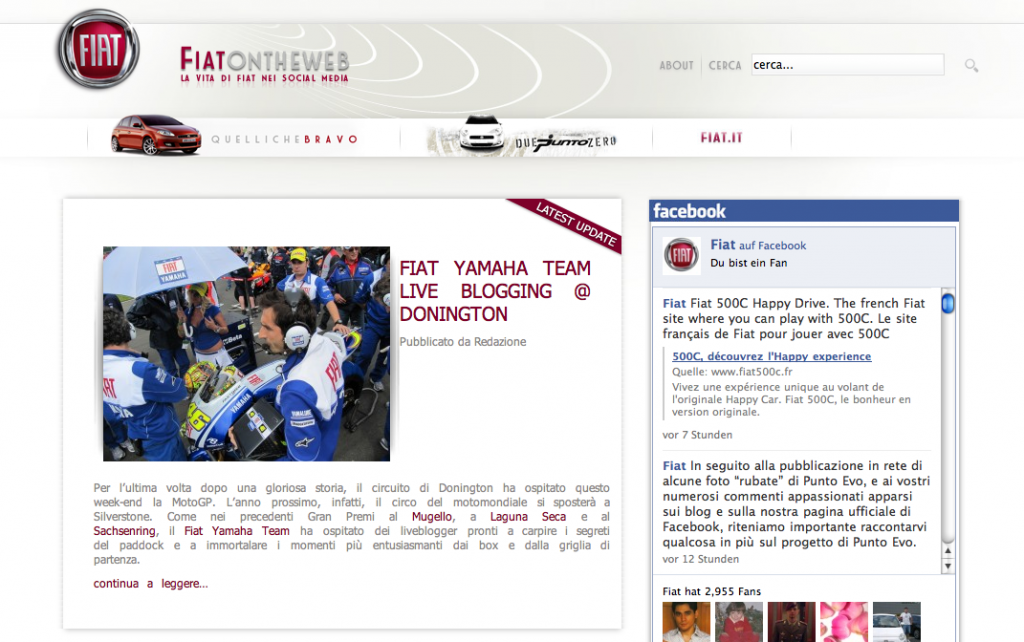von Roland Hachmann | Juli 30, 2009 | Blog, Digital Marketing, Digital News, Social Media Marketing
We’ve seen quite a few examples of corporate sites mashing up social media content and presenting it on a single page. Jeep is one of the earliest examples I can remember (they seem to have some special right now, called „urban ranger“).
Now, since June there is Fiat on the web. A wordpress powered site – actually a blog – with all the ingredients: a facebook widget, a youtube gallery, same with flickr, friendfeed is integrated, delicious links accessible, latest twitter updates: every „mandatory“ item seems to be present.

I am not mentioning that because it appears so fantastically special. Instead, I am slowly getting the perception that these kind of social brand presence aggregator sites are become „business as usual“. Or rather: should be considered by brand marketers as a mandatory online marketing component. Yet: how many of those sites have we really seen? How many brands actually have sufficient social media presences in order to justify such a site?
von Roland Hachmann | Sep. 13, 2006 | Blog, Digital Culture, Digital Marketing, Digital News
There is a rather interesting story on Technology Review by James Surowiecki, who wrote the book „wisdom of the crowds“ (very recommendable) and is also a writer for the New Yorker. He interviewed Joshua Schachter, who founded del.icio.us and later on sold it to Yahoo!. He was one of the first to introduce the tagging-system to organise information. A very useful invention, since the internet is more and more becoming a jungled web of microcontent that resides (for example) in blogs, addressable by permalinks. You find an article, you loose an article. And if Google decides to change their algorithm from one month to another, you will most likely never find that piece of information again. And here comes del.icio.us. Invented by Schachter for that one sole purpose: have a well functioning bookmarking system, in which you can find information sorted by your own criteria, i.e. tags. He first only built it for himself, but soon noticed the power of it. Later he sold it to Yahoo! and now he thinks about how to increase the user base from the still rather small number of 300.000 to a number that more resembles the „early majority“:
But even as tagging has become an industry buzzword that businesses are straining to associate themselves with, Schachter is confronting the fact that the vast majority of people on the Web don’t tag at all–and probably have never even heard of tagging. So how does he expand his sites audience? „You have to solve a problem that people actually have,“ Schachter says. „But it’s not always a problem that they know they have, so that’s tricky.“
I had the same problem. I wanted to manage the microcontent that’s out there on the web, but I didn’t have a useful tool except bookmarks, which are tedious to manage. And even when I started using del.icio.us, I had to get used to it. Quite frequently I forgot to press the del.icio.us button and then, a couple of surfs away, I noticed it.
However, tagging and folksonomies are great, when it comes to organising information in a swarm like behaviour. And it is especially nice for the companies engaging their users in this manner:
The real magic of folksonomies–and the reason sites like del.icio.us can create so much value with so little hired labor–is that they require no effort from users beyond their local work of tagging pages for themselves. It just happens that the by-product of that work is a very useful system for organizing information.
– which leads me to another news item:
Google Image Labeler asks users to associate tags with images taken from their image search. Clever move. To better organise their image search, they moved to a folksonomy. Asking people to tag pictures, instead of looking for meta-information on the page the image is located on, will greatly improve the relevance of the results of their image search.
Of course, you ask yourself: why would anyone go through the effort of tagging other people’s pictures for no good reason? Well, Google made a game out of it. You play against another user. Within 1.5 minutes you have to put as many tags against images, as possible. Whoever has more, wins. (I just haven’t found yet, what you can actually win.)
Very clever, indeed…
(via, at least the first part.)


 Wo ich sonst so bin...
Wo ich sonst so bin...